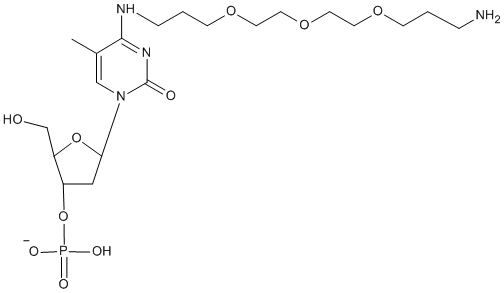Amino Modifier TEG mdC Amidite (5'-DMT-mdC(TEG-Amino-TFA))
Amino Modifier TEG mdC Amidite (5'-DMT-mdC(TEG-Amino-TFA))
Amino Modifier TEG mdC Amidite (5'-DMT-mdC(TEG-Amino-TFA)), 250 mg, ABI (5 mL / 20 mm Septum)
Key features
Show- Incorporates primary amine internally to an oligonucleotide, for subsequent conjugation.
- Base labile trifluoroacetate (TFA) group useful where purifcation "handle" is not necessary.
- Triethyleneglycol linker minimises interaction of label with the double stranded duplex, but also confers additional hydrophilicity.
Usually shipped in 10-15 Days, Made To Order
Product information
Incorporation of a primary amine reactive functional group at specific sites within an oligonucleotide allows for subsequent post-synthesis conjugation of the oligo with a number of different affinity, reporter or protein labels, depending on the application. Such labels need to be reactive towards the incorporated functional group: for example, NHS esters or isothiocyanates will react with primary amines. This approach is often necessary where the desired label or tag is either not available as a phosphoramidite, or is sensitive or unstable to the conditions of oligonucleotide synthesis or deprotection. A common example is the attachment of a rhodamine dye using the TAMRA NHS ester. Functionally-derivatised oligos can also be covalently attached to surfaces such as glass slides or gold microspheres for use in various microarray or nanoelectronic applications. Internal amino-functions, ready for further post-synthetic modification, can be introduced to oligonucleotides by a number of products. The correct choice is dependent primarily on the nucleobase and linker combination you desire, the former simply being chose as per your desired sequence. In the case of the C6 analogues, after deprotection, the primary amine is distanced from the oligonucleotide by a total of 10 atoms and can be labelled or attached to a biomolecule such as an enzyme. Similarly, in the mdC TEG products, the amine group is attached to a modified cytidine residue via triethyleneglycol linker, making it less likely for the label to interact with the double stranded duplex, but also conferring additional hydrophilicity. A C2 spacer is more appropriate for applications where the attached label is designed to interact with the oligonucleotide. The C6-dA product is useful for introducing an amino function at a dA site, although the linker on the 8-position does cause some destabilisation of the duplex pairing to T (approximately 2 ºC per insertion). Applications of the internal modification technique are varied. For example, when synthesising wavelength shifting FRET probes using FAM/ROX, combine the ROX-modified amino-dT with a FAM modification at the 5'-end.
Properties:
- Formula: C52H70F3N6O11P
- Molecular Weight: 1043.12
- Appearance: white solid
- Extinction Coefficient at 260 nm: 7050
Product usage:
- Dilution: 100 mg/mL
- Deprotection conditions: To avoid a secondary alkylation acryonitrile reacton, which occurs during normal cleavage and deprotection of amine modified oligos, flush column for 15 minutes with 1 mL of 10% diethylamine (Aldrich #471216) in MeCN. Rinse column with MeCN before cleavage and deprotection of the amine labeled oligo. If using standard amidites [i.e., A(Bz), G(iBu)] deprotect in concentrated NH4OH for 5 hours at 60 °C. If using fast deprotecting amidites [i.e., C(Ac), G(DMF), G(PAC)] deprotect in concentrated NH4OH for 1 hour at 60 °C. Note: under these conditions the TFA group will be removed. Amine Labeling:Amino Modifier TEG mdC reacts in a manner identical to a normal phosphoramidite monomer. If labeling the 5' terminus, the DMT group may be left on after the synthesis for reverse-phase cartridge purification.Oligo should be cleaved, deprotected, and purified before labeling. For reporter groups, protein labels, NHS, and enzymes see manufacturer's labeling protocol.Image of cleaved and deprotected structure:
- The mass this product adds after conjugation and work-up (the additional mass seen by mass spectrometry) is: 506.49

Storage and handling:
- Shipping conditions: Cold
- Storage conditions: -15 to -30 °C
Access support
Need some support with placing an order, setting up an account, or finding the right protocol?
Contact us